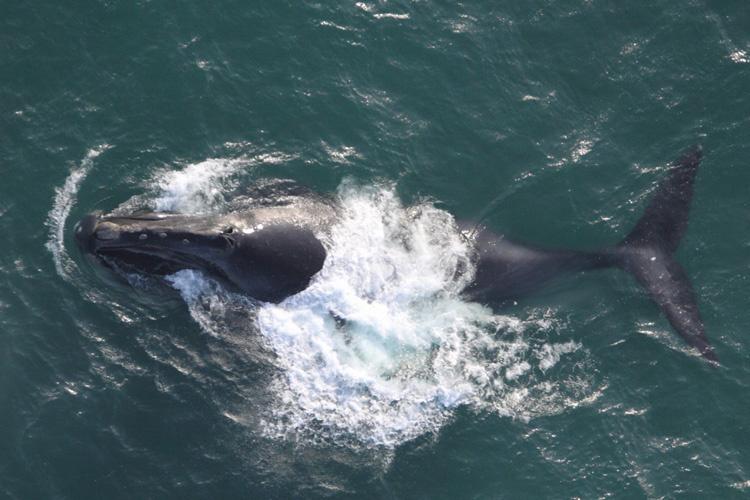High
North Pacific right whales are one of the rarest whale species, and the stock that occasionally visits Washington is very small. Threats to the stock are poorly understood, but ship strikes, fisheries entanglements, marine debris, human-generated marine sound, climate change, and small population size may be impeding recovery.
Marine mammals are protected under the Marine Mammal Protection Act. To report a dead, injured or stranded marine mammal, please call the National Oceanic and Atmospheric Administration (NOAA) West Coast Region Stranding Network hotline: 1-866-767-6114.
Description and Range
Physical description
North Pacific right whales are a large, slow-swimming baleen whale with a stocky black body and no dorsal fin. This species may weigh up to 100 tons and be 45 to 64 feet in length.
Ecology and life history
North Pacific right whales are thought to migrate between higher latitudes during spring and summer and lower latitudes in winter. The species mainly inhabits coastal and continental shelf waters but is sometimes found in deep waters. Occurrence is often strongly linked to areas of high prey abundance.
Diet consists of zooplankton, especially copepods in shelf, shelf edge, and deeper oceanic waters. These whales feed by swimming continuously with their mouths open and filtering prey against the baleen, a behavior known as skimming.
Females give birth to their first calf at 9 to 10 years of age, and calving occurs in coastal waters during winter. Calving may occur every three to five years based on calving rates of similar species. Weaning takes place at about one year of age. This species may live up to 70 years.
Geographic range
North Pacific right whale distribution is restricted to the Pacific Ocean between 20 degrees and 60 degrees north latitude, with most remaining individuals concentrating in the northwestern Pacific and Bering Sea. Migration and winter distribution are poorly understood.
Individuals in the northeastern Pacific, including Washington, belong to the Eastern North Pacific stock. There are only size of this stock probably numbers about 30 whales remaining in this stock, with no sign of recovery. Population trends for this stock are unknown, but sighting of calves are rare. Stock members are very rare visitors south of Alaska, with just a handful of records off the outer coast of Washington since the early 1900s. At least seven confirmed records off British Columbia, Oregon, California, and Mexico since 1994 suggest that the species still rarely visits Washington. The last visual observation of a North Pacific right whale off Washington was in 1992, although two calls were detected by hydrophone off the Washington coast in 2013.
For a map of range-wide distribution and conservation status of this species, check out NatureServe Explorer and the International Union for Conservation of Nature Red List.
Climate vulnerability
Sensitivity to climate change
Moderate-
High
Limited information is available regarding the sensitivity of North Pacific right whales to climate change, but the small population size of this species increases its vulnerability to this threat. North Pacific right whales will most likely be impacted through changes in abundance and distribution of their primary prey, copepods. Because right whales are limited in the type of prey they can consume and require large aggregations of copepods for optimal feeding, declines in copepod production and distribution, which could be triggered by changing ocean circulation and sea ice extent, increases in ocean acidity, or increases in ocean temperatures, could greatly impact this species. Decreases in copepod availability could lead to reduced reproductive output and decreased calf and adult survival, and could alter migration patterns.
Exposure to climate change
High
- >Increases in ocean acidity
- Increased ocean temperatures
- Altered circulation and/or upwelling pattern
Conservation
Conservation Threats and Actions Needed
- Resource information collection needs
- Threat: Document sightings in Washington and identify potential threats in state waters.
- Action Needed: Expand efforts to document the species in Washington waters.
- Overharvesting of biological resources
- Threat: Ship strikes are a relatively important source of mortality and injury off the U.S. west coast.
- Action Needed: Identify areas of greatest concern for ship strikes and work with the shipping industry to reduce this threat.
- Threat: Entanglement in fisheries gear (netting, pots, and traps) is a cause of mortality and injury off the U.S. west coast.
- Action Needed: Determine ongoing sources of bycatch and manage those fisheries to reduce bycatch.
See the Climate vulnerability section above for detailed information about the threats posed by climate change to this species.
Resources
References
Caretta, J.V., E.M. Oleson, K.A. Forney, M.M. Muto, D.W. Weller, A.R. Lang, J. Baker, B. Hanson, A.J. Orr, J. Barlow, J.E. Moore, and R.L. Brownell Jr. 2021. U.S. Pacific Marine Mammal Stock Assessments: 2020. U.S. Department of Commerce, NOAA Technical Memorandum NMFS-SWFSC-646.
Carretta, J. V., E. Oleson, D. W. Weller, A. R. Lang, K. A. Forney, J. Baker, B. Hanson, K. Martien, M. M. Muto, A. J. Orr, H. Huber, M. S. Lowry, J. Barlow, D. Lynch, L. Carswell, R. L. Brownell Jr., and D. K. Mattila. 2014. U.S. Pacific Marine Mammal Stock Assessments: 2013. NOAA Technical Memorandum, NOAA-TMNMFS-SWFSC-532. 406 p.
NMFS. 2013. Final recovery plan for the North Pacific right whale (Eubalaena japonica). National Marine Fisheries Service, Silver Spring, Maryland.
Scarff, J. 2013. Records of North Pacific right whales along the coasts of California, Baja, Oregon and Washington. http://www.sfcelticmusic.com/js/RTWHALES/WestCoast_sightings.htm
Thomas, P. 2014. ‘Astonishing’ North Pacific right whale sighting only in second in 62 years off British Columbia. http://www.grindtv.com/outdoor/nature/post/astonishing-north-pacific-right-whale-sighting-is-only-the-second-in-62-years-off-british-columbia/
